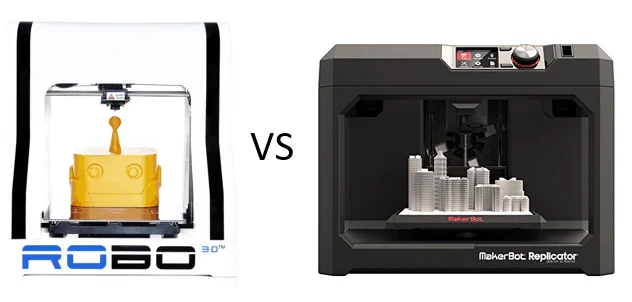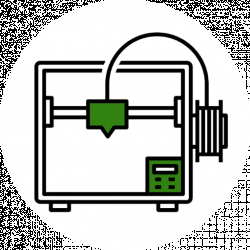- Creality Ender vs Anet A8 [2022]: Which is Better? - April 14, 2022
- TEVO Tornado Review [2022] All You Need To Know - April 6, 2022
- Anet A6 Review [2022 UPDATED Version] - April 5, 2022
3D printers have been fascinating the hobbyist and technology buffs for several years now. When they were first offered for sale to the general public, most models were still a bit rough around the edges and unrefined. The capabilities of 3D printers are pretty amazing, even when they first arrived on the tech scene.
There have been a vast number of predictions about just how advanced 3D printers will become and perhaps more interesting when they will be able to perform certain tasks. Many of those issues still remain to be settled. However, the 3D printers offered for sale now are light years ahead of the models offered a few years ago.
Table of Contents
Two Very Different Roads to Success
Robo 3D is based in San Diego, California and first began in 2012. The company was formed by a group of university students who came together to design a 3D printer with the intention of offering a cheaper alternative to the marketplace
Their quest to produce the R1 began on Kickstarter.com with a goal to raise just under $50,000 to get the company started. They ended up receiving a total of over $649,000 and became one of the most successful Kickstarter campaigns on record.
MakerBot Industries began in 2009 and they call New York City home. MakerBot got its start with a total of $75,000 in funds raised from private investors. Just two years later, a venture capital operation invested ten million in MakerBot and not too long after that in 2013, Stratasys Inc. acquired MakerBot in a deal that was worth a reported 400 million. Needless to say, the rise of MakerBot into the ranks of influential 3D printing companies has been nothing short of amazing.
Both companies have achieved incredible success and offer quality products well received in the marketplace. We had a look at a 3D printer model from each of these companies and will give you the run down on exactly what they can do, can’t do and what to expect. Let’s have a closer look.
Robo 3D R1 Plus vs MakerBot Replicator 5th Generation
The Basics
Robo 3D R1 Plus
MSRP: $799.99 (see here for latest pricing)
Warranty: 6 Month Warranty Covering Replacement Parts and Manufacturer Defects
Manufacturer: Robo
MakerBot Replicator 5th Gen
MSRP: $2899.99 (see here for latest pricing)
Warranty: 6 Month Warranty Covering Replacement Parts and Manufacturer Defects
Manufacturer: MakerBot Industries
Features and Operation
Robo 3D R1 Plus
- Auto Calibration
- Micro SD Print Capable
- Parts Replacement Warranty-Six Months
- 300g Spool of Blue filament Included
- Ships Fully Assembled
- Improved Linear Motion Functionality and Control Rods and Linear Bearings
- Rod and Bearing Upgrades
- Can use PLA/ABS/LAYWOOD/Specialty Filaments
- Including Spool Holder: Dimensions 15 x 22 x 18.25 inches/38.1 x 55.88 x 46.35 centimeters
- Single Head
- 10 x 10 Bed with Heated Surface
- 10 x 9 x 8 Large Build Volume
- 4mm Hexagon Metal Nozzle;
- 75mm Filament
- Plastic Injection Molded Parts
- 8im8uu Bearings Provide Precise Movement
- Five Nema 17 Motors
- 12v 30amp Power Supply-Good for 115v/230v
- 100 Micron Resolution
The R1 Plus comes fully assembled and ready for use with just a few easy steps in the setup process to get the unit configured properly. Once you start printing you may have to spend some time making adjustments to different settings with some trial and error, but getting the unit powered up and ready to go is not an issue.
The Robo R1 Plus comes with an automatic leveling feature that helps you easily calibrate the machine. In addition, there are settings available within the software that allows you to make adjustments to calibrations as well tweak other system settings.
In fact, you can even adjust the resolution to between 0.1 to 0.3 millimeters. Once you have the unit calibrated, it prints very accurate designs and while it is not the fastest 3D printer on the planet, it is better than many other models. However, it is certainly not built for high volume commercial projects so realistic expectations are important.
The print bed is much larger than many other 3D printers in the budget category, which we found to be a big advantage while using the printer. The finished parts do require a bit of clean up as they may have small strands that need to be clipped and trimmed, but overall the operation is excellent for a printer in the under $1,000 price range.
MakerBot Replicator
- Vol. 25.2×19.9×15.0 centimeters/9.9×7.8×5.9 inches
- 7,522 Cubic cm or 456 cu. In.
- Technology-Fused Deposition Modeling
- Layer Res: 100 Microns
- Filament Diameter: 1.75 mm
- PLA Filament Two Lbs. Spool
- Diameter of Nozzle-0.4 mm
- Glass Build Platform
- STL, OBJ, Thing, MakerBot File Types
- Connectivity: USB & Ethernet
- Operating Systems
- Windows 7 or newer
- OS X 10.7 or newer
- Linux
The setup process for the MakerBot Replicator feels almost like setting up a home computer. Once you take the unit out of the box, you plug it in and press the power button. In just a few seconds, the display lights up and begins to walk you through the various steps. You will want to have an internet connection readily available as the first step the printer does it run through an update process.
The extruder that comes with the MakerBot Replicator is a bit interesting as it attaches to the printer assembly via magnet. While it is a bit different the connection seems to be sturdy and hold up just fine throughout printing operations.
Although, one known issue is the extruders have a tendency to get clogged, which can create a bit of an inconvenience. Due to MakerBot’s warranty conditions, you cannot open the extruders without voiding the warranty. Therefore, if you get clogged extruder, it must be sent back to MakerBot for replacement and not repaired locally.
The MakerBot provides a lot of flexibility and some unique features such as the built-in camera that allows you to snap photos of print jobs in different stages and share them online. The unit provides a very nice quality print, but it is fairly loud and not something you would want to use in close proximity to others. The setup is easy, print quality is good and the extra features like the camera are a nice touch.
Verdict: Makerbot vs Robo 3D
The MakerBot Replicator and Robo R1 Plus are both nice printers, but they are in two very different price categories. With the R1 Plus priced at approximately $800 and the Replicator at approximately $2900 the expectations in performance should be significantly different. The Replicator certainly feels a bit more refined out of the box in terms of construction as well as fit and finish.
However, when it comes down to print quality is it worth another $2,000? In our opinion, probably not. The print quality is acceptable and the unit does have some extra features but just not enough for us to justify a price difference of quite that much.
Of course, it is also important to keep in mind the R1 Plus is a rather exceptional model when compared to the competition. It would give almost any other model a run for its money in terms of best value. If we had to choose we would say keep a few extra dollars in your pocket and buy the R1 Plus.


